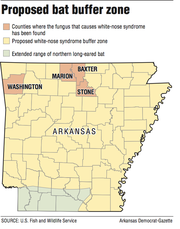The U.S. Fish and Wildlife Service offered an option Thursday to protect northern long-eared bats while limiting regulatory burden on the public.
The agency is proposing a special rule under section 4(d) of the Endangered Species Act. The rule would allow the service to relax the normal restrictions to reduce conflicts between people and protection.
The designation would give the service more latitude to protect the bats, but it would be less restrictive than a designation of "endangered," said Georgia Parham, a spokesman for the service.
An endangered designation could eliminate forest harvesting in Arkansas from April through September to protect the bat's habitat, the office of U.S. Sen. John Boozman, R-Ark., said in a news release.
Forestry in Arkansas accounts for more than 27,000 jobs, with an economic impact of more than $2.6 billion, according to the Senator's office.
Boozman and 12 other senators sent a letter Wednesday to Dan Ash, director of the Fish and Wildlife Service, urging him to consider the 4(d) rule.
In October 2013, the service proposed the endangered designation for the northern long-eared bat. The species has been decimated in some parts of the country by the fungus that causes white-nose syndrome. A final decision on the proposal is due by April 2. Arkansas is on the southwestern edge of the bat's habitat, which extends east to the Atlantic coast and north into Canada.
The letter, signed by seven Republicans and six Democrats, noted that white-nose syndrome has been found in only 17 of the 39 states that constitute the range, and the forest products industry had concerns about restrictions from an endangered designation.
Arkansas is one of those states where the disease has been found.
Blake Sass, nongame mammal program leader for the Arkansas Game & Fish Commission, said bats that died of white-nose syndrome have been found in two Arkansas counties: Stone and Marion.
He said the white-nose fungus has been found in caves in two other Arkansas counties: Washington and Baxter.
Almost all of Arkansas would fall under a buffer zone of protection under the 4(d) rule, Parham said. The buffer zone includes areas within a 150-mile radius of counties where white-nose syndrome has been found.
The 4(d) rule proposal will appear in the Federal Register today, opening a 60-day public comment period.
The rule can be implemented only if the species is designated as threatened. The service could ultimately decide on a designation of endangered or no designation at all.
Boozman said bats are beneficial but the focus needs to be on the disease.
"Bats are an important part of our ecosystem, helping to consume insect pests, and the effect of white-nose syndrome on the northern long-eared bat population is a serious problem," Boozman said Thursday. "But forestry activities are not the problem. I am listening to all concerned Arkansans, because so far the service is not providing the guarantee we need -- under the Section 4(d) authority -- that the focus will be on the real problem -- the disease that is harming these bats."
DeeAnn Reeder, a professor at Bucknell University in Lewisburg, Pa., estimates white-nose syndrome has killed 6.7 million North American bats since it was first detected a decade ago in New York state.
Reeder said for every million bats that die, 692 tons of insects that would have been eaten by the bats survive the summer months, according to a news release from Bucknell.
Sasse said he doesn't know how many northern long-eared bats are in Arkansas, but there's no indication the population has declined since white-nose syndrome was discovered.
Forest management practices in Arkansas apparently haven't affected the species, he said.
The commission's forest management practices can provide a better habitat for the bats by thinning woods, which attracts insects and provides areas for the bats to forage, said Sasse. But woods where the bats are known to be roosting would be avoided.
Under the act, an endangered designation indicates a species is currently in danger of extinction throughout all or a significant portion of its range. A threatened designation means a species is likely to become endangered in the foreseeable future.
The act and the service's implementing regulations prohibit "take," which includes harming, harassing and killing of endangered and threatened species, unless otherwise permitted.
For areas of the country affected by white-nose syndrome, the proposed 4(d) rule would exempt certain practices that could harm, harass or kill the bats, according to a news release Thursday from the Fish and Wildlife Service.
Those practices include forest management, maintenance and limited expansion of transportation and utility rights-of-way, removal of trees and brush to maintain prairie habitat, and limited tree removal projects -- provided these activities protect known maternity roosts and winter hibernation shelters.
The removal of hazardous trees would also be allowed under the 4(d) rule, as would research-related activities and the removal of northern long-eared bats from human dwellings.
These measures are designed to protect the bats when they are most vulnerable, including when they occupy winter hibernation shelters and during the two-month pup-rearing season in June and July, according to the release.
Comments can be made online at regulations.gov. In the Search box, enter Docket No. FWS--R5--ES--2011--0024.
Comments can also be made via U.S. mail to: Division of Policy and Directives Management; U.S. Fish and Wildlife Service, MS: BPHC; 5275 Leesburg Pike, Falls Church, Va. 22041-3803. The above docket number should be cited in the letter.
NW News on 01/16/2015

